Time and experience have proven that advertising serves many important roles for companies: it quickly captures the interest of your intended audience, keeps loyal customers engaged with your product, and helps expand your base of potential customers. These are just a few benefits of leveraging media planning.
To get your advertisement out there—whether it's online, in printed publications, or through broadcast channels—you need to secure and purchase the right advertising space. This can be a time-consuming task, which is why there are now specialized platforms designed to streamline the process. These platforms, known as programmatic platforms, reduce the need for manual intervention in buying and planning media space.
Programmatic advertising, facilitated by these platforms, automates the media buying process and optimizes it through algorithms and a self-learning system that improves its efficiency based on past transactions.
The act of acquiring media space to subsequently resell to advertisers has come to be known as Media Buying or Media Planning. These processes have significantly transformed the landscape of advertising by introducing efficiency and intelligence to the methods in which ads are placed.

What is Media Buying?
Media buying refers to acquiring advertising space across platforms such as TV, radio, websites, and social media to reach targeted audiences effectively. It involves negotiating costs, selecting optimal channels, and scheduling ads for the best timing. In digital marketing, media buying emphasizes programmatic ad placements, real-time bidding, and campaign optimization to boost ROI. The core objective is to reach the right audience at the most opportune moment, maximizing visibility while controlling expenses. Effective media buying demands thorough data analysis, strategic planning, and continuous performance monitoring to ensure successful outcomes and efficient use of resources.
What is the Difference Between Media Planning and Buying?
Today, one of the most rapidly expanding sectors in media purchasing is media buying in digital marketing. It's becoming hugely significant, fundamentally reshaping how businesses operate and how we, as ordinary people, experience our daily lives. What makes digital advertising stand out is its ability to directly engage with target audiences, whether they're browsing websites, scrolling through social media, or using mobile apps.
When exploring the nuances of media buying vs media planning in the context of digital advertising, it's essential to understand what you're engaging in is essentially renting ad space for a specific duration, as set forth in the agreement. Looking at banner ads on social media through the lens of a media buying example reveals that their cost is intricately connected to the volume of site traffic, especially from those within your target demographic.
Delving deeper into the pricing mechanisms, which are central to media planning, reveals that these can vary according to a multitude of factors. This variation could depend on several metrics such as the frequency of ad clicks from diverse platforms, the amount of exposure or views an ad garners, and any consequent purchases made by potential customers influenced by the ad. Interestingly, when shifting the focus to traditional media platforms like radio and TV, a notable contrast in the cost structure emerges. In these realms, typically dominated by media buying strategies, prices are calculated by the minute, with TV ad expenditure also factoring in channel ratings, showcasing a distinct difference from digital media cost determinants.
Then there's outdoor advertising – think billboards on the street or on public transport. Location plays a huge role in pricing here, as does the size of the billboard and the materials used to make it. As for print media, promoting your company can cost more depending on the region and how popular the publication is.
The Media Buying Process
Navigating the world of digital media planning and buying is a craft that requires a keen understanding of how to strategically negotiate and secure ad placements. Achieving success in media buying in advertising isn't just about crunching numbers or following a formula; it's about blending science with art. To demystify this process, let's delve into the 5 fundamental steps that lay the groundwork for effective strategy. Through the lens of digital media buying and planning, businesses and brands can forge meaningful connections with their audience, guiding them through the four key phases of their purchasing journey.
The five steps of the media planning and media buying process are:
Market Research
Determine your target audience after comprehensive market research of your business niche;
Understand Interests
Understand the interests of your audience;
Find Your Audience
Find your audience and understand when they are most receptive to your messages;
Create Captivating Content
Provide captivating creative that motivates them to take action;
Test and Refine
Test and retest ad placements and creatives to find out what works and what doesn't. Refine and improve your ad campaigns.
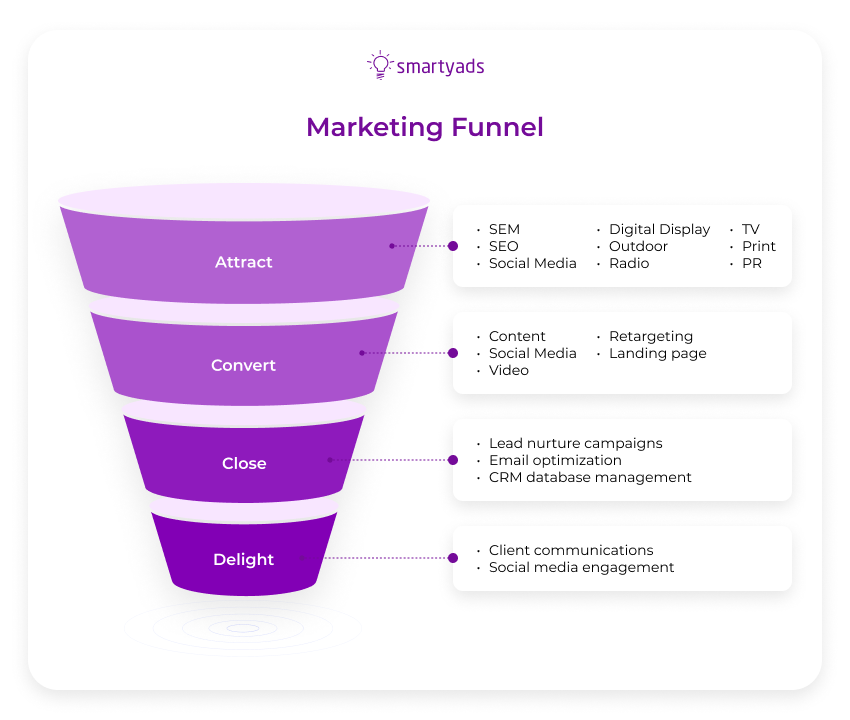
The first step of the media planning process involves using research tactics that you can utilize to know and understand your ideal target audience.
However, you need to not just engage your audience with content related to your product, but also get them interested in purchasing your product or service.
Why is Media Buying Important?
Reaching the Right Audience
Media buying is key for reaching the right audience. It's all about choosing the right spots—be it on social media, TV, or online—where your target demographic hangs out. This way, you're not just throwing your message out there; you're making sure it lands in front of the people most likely to be interested, increasing your chances of catching their attention and getting them to act.
Optimizing Advertising Budgets
Media buying allows brands to make the most of their ad budgets by securing optimal deals and placements for their campaigns. By analyzing media channels and pricing, media buyers ensure brands achieve high value, focusing on cost-effective platforms that offer high visibility or engagement.
Building Brand Visibility
Media buying plays a crucial role in boosting brand visibility. By strategically planning and executing media buys, companies can enhance their presence on various platforms. This ongoing exposure is key in strengthening brand recognition and trust among audiences, ensuring the brand stays in the forefront of consumers' minds when they're ready to buy.
Tracking and Measuring Success
Media buying is crucial because it lets businesses track their ad campaigns' performance, allowing for instant tweaks to improve results continuously.
Gaining a Competitive Edge
In a crowded market, the right media buying strategy can give brands a competitive edge by securing premium ad placements and staying relevant for consumers.
Marketing research to study the target audience
Internal market research
To begin with, what's a media buyer needs to learn about the business and the nuances involved in running it. This is especially important if the media buyer is an outside hire who was invited specifically for the purpose of media buying or media planning for a particular company.
Such research helps media buyers to better understand the target audience and the company's needs and to prepare the ground for conducting external research.
External market research
Such research is necessary for all media buyers in order to study the situation in the target market. For full-scale external research, the media buyers study the target audience, the media resources, which can be used to reach it, and the time, when the target audience is most likely to be active. Based on all of this data, media buyers can get a fairly reliable picture of when, where, and how best to get views and conversions from a particular advertising offer.
Media buyers can also establish media goals based on this data.
Establishing Media Goals
After performing market research and studying the target audience, media planners must figure out which media channels will be most effective for the business. These can range from traditional media such as newspapers and magazines, outdoor advertising, radio or television, or innovative media channels such as programmatic advertising, CTV, DOOH, or native advertising.
Of course, modern forms of media competitively win over traditional media, because with less investment and due to more accurate targeting, they show better results.
In addition, any change in a programmatic ad campaign can be quantified and its effect on the final result can be counted by media buyers. With traditional media, analytics is much less accurate.
However, there is a certain percentage of the audience that is still easier to reach through traditional media. Besides, for large corporations, traditional media is more of a tool to increase brand awareness and an auxiliary source of potential customers.
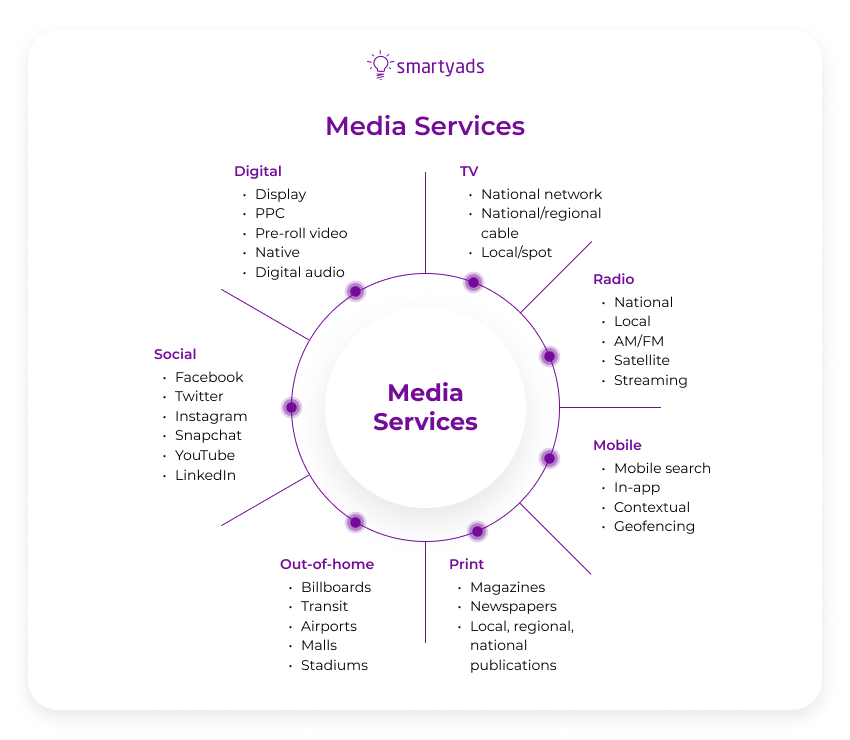
After analyzing the various media channels and setting goals, a good media buyer is likely to be interested in what inventory a particular advertising platform has to offer.
It's hard to say what kind of inventory would be good for any particular business, but that's the question a good media buyer should know the answer to. At the very least, if you don't have a media buyer at your disposal, you can always ask for help from the technical support of a potential programmatic platform, usually, such platforms provide consulting services.

Types of media buying
Programmatic advertising on digital displays
It's the type of digital media buying. The main advantage of programmatic digital display advertising is its ability to target a specific audience, depending on its position in the sales funnel.
Today, the criteria for targeting are limitless. It often makes sense to create a targeting audience using your own data, such as a list of current customers of the product or service you want to promote. Use smart data visualization and analytics tools to identify similarities and similar audiences that match the profiles of those customers.
Once you've compiled this list, you'll have your ideal target audience. You can target them with messages from your company or by using specific ad space for ad placements.
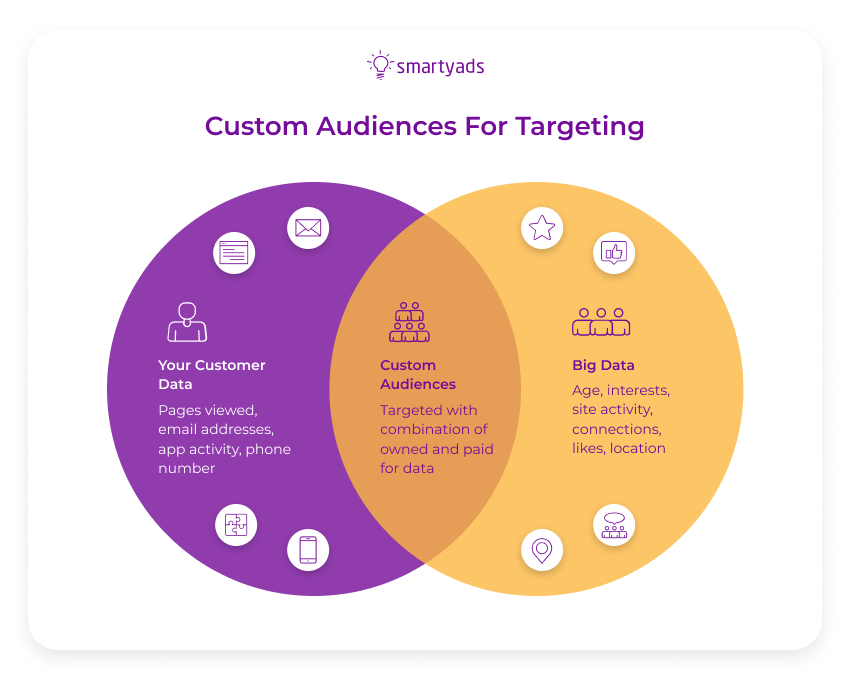
Once you've identified your ideal audience, you can add additional target audiences based on their position in your sales funnel.
Additional criteria for supplementing your audience:
- Demographic variables;
- Geographic/geo-zone variables;
- Behavioral variables;
- Keywords (SEO targeting);
- Categories of interest;
- Targeting by IP address;
- Audience of interested media buyers;
- Similar audiences and custom audiences;
- Retargeting and remarketing.
Marketing funnel targeting looks like this:
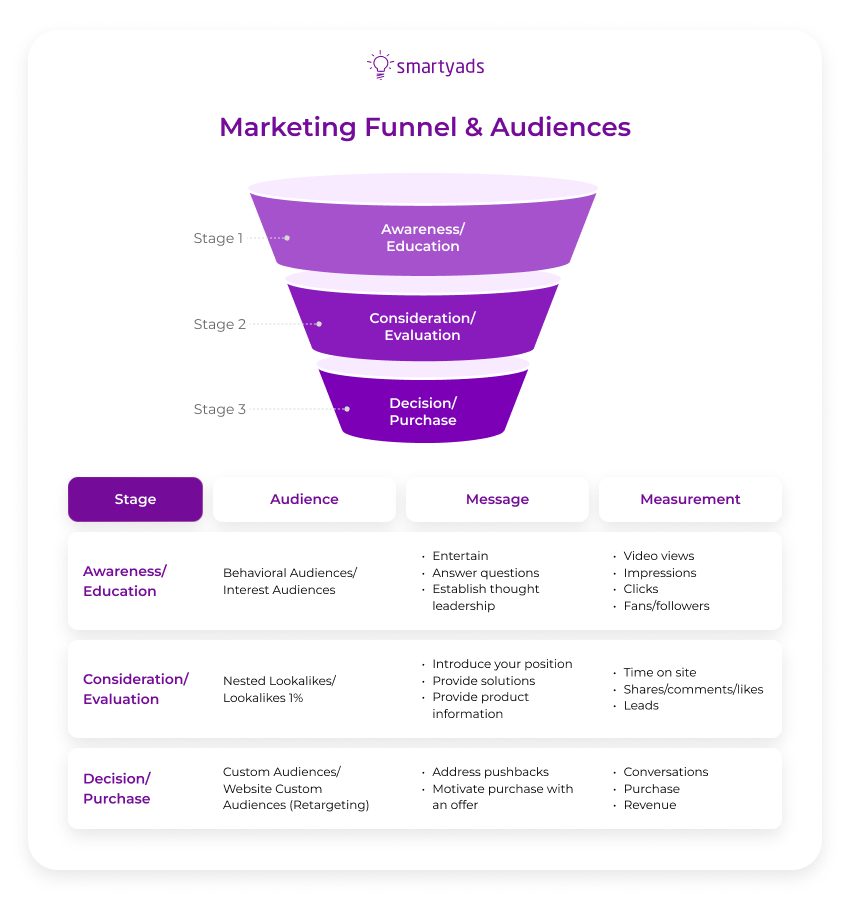
All of the messages and creatives that a potential customer sees should resonate with each other and complement each other in order to move them further down the sales funnel.
Different media payment models
Today, there are several models of online media buying, which can be used simultaneously on different platforms, depending on your budget:
CPC (Cost Per Click)
Price per click. The most popular media buying model. In this case, the advertiser pays only when the user who viewed the ad, makes the desired target action (for example, moves to the site).
CPL (Cost Per Lead)
The price per lead. The advertiser pays for advertising only when the user filled in and sent a form to potential clients. This form is rarely used because it is not profitable for the publishers, and is usually found in the B2B marketing sector where the user needs to first contact the company before making a purchase.
CPA (Cost Per Action)
Price per action. The advertiser pays when a user performs a certain action on their site. For example, buys, registers, subscribes, etc.
CPM (Cost Per Mille)
The price per thousand impressions. The advertiser pays for their ad just to be shown, regardless of the effectiveness of that display, but the payment is made for every thousand impressions.
CPI (Cost Per Install)
The price per install. This model is relevant only for mobile and computer applications when the advertiser pays for each download of their software to the user's computer or phone.
It's all also types of digital media buying. As you know, most customers today do a little research on the Internet before they buy anything. Therefore, pay-per-click advertising can be a profitable investment to increase conversions.
At the same time, pay-per-thousand-view ads are good for increasing audience awareness of your brand. By placing ads in front of users who are searching for keywords based on intent, you increase your chances of increasing awareness and attracting leads.
You can use the following criteria to target your audience for such ads:
- Age;
- Gender;
- Parental or marital status;
- Family income;
- Social status;
- Level of education.
Once the ad campaign is set up and configured, don't forget to correct it and analyze the results. A successful ad campaign will always be just one step ahead, but that doesn't mean you should stop striving for it.
Media Buying Trends
The way we buy media has changed a lot due to digital platforms and shifts in consumer behavior. Social networks are now key advertising channels, while traditional media like TV and radio are finding new relevance. Brands must adapt to this more complex landscape by choosing the right platforms and media buying strategies to engage audiences effectively. Let's explore the trends shaping modern media buying.
Media buying on social networks
Whereas social networks used to be just a tool for social interaction, today, beyond their original function, they have become a platform for advertising or sales as well as the media planning phase. Many users skip the search page and prefer to make purchases directly through social networks. Purchase decisions are no longer made on a particular product or service page, but on the expanses of Twitter, Facebook, Instagram, and YouTube.
Social networks are paid media because it is possible to achieve organic growth of subscribers, but in a highly competitive environment it is extremely difficult and unprofitable in terms of the time it may take. It is much easier to use the services of paid advertising in a social network and get the necessary flow of traffic from some advertising proposal.
It's important to be aware of which social network your audience may be on. You can call it marketing ageism, but it's obviously easier to find older audiences on Facebook now, while it's easier to find zoomers and millennials on Instagram or Tiktok.
With solid media buying marketing, you can achieve your goals by using paid advertising tools on social media.
Media buying on radio and television
While the first thing we think of when talking about digital marketing is media buying on search engines or social media, we shouldn't forget traditional channels for media buying either.
Radio and television, like any other media, are moving with the times and developing their own methods to update their advertising platforms. Now traditional linear TV is losing ground to CTV and OTT, but both linear TV and streaming services are great channels to reach your potential customers.
Depending on your ad campaign goals, budget, and ad creative options, you may find it appropriate to use some of these media. For analytics, independent ratings like Nielsen, ComScore ratings, TVB, and Scarborough information are very advantageous. They can help you choose where to place ads and predict their effectiveness.
Many media buyers forget about radio or don't consider it a worthwhile channel, but today radio is also a great way to target your ads. For example, streaming services like Pandora, Spotify, and iHeartRadio allow listeners to create their own playlists. This means that people are more likely to listen to recordings for longer, creating opportunities to revisit your messages.
In addition, if your brand is targeting an audience in a particular location, it may be a good solution to reach out to a local radio station.
Media buying and SEO
Search engine optimization is a scary word that everyone is familiar with, but only a few know it closely. SEO can be part of a media buying strategy, so it should not be forgotten about when we talk about media buying or media planning process.
Search engine optimization is a specific list of actions aimed at ensuring that your site has a higher position in the search results from Google, Bing, or Yahoo. These actions can be directed to optimize the content of your site and on the technical side. That's why it's crucial, if not to have your own SEO specialist, then at least to regularly request audits from third-party companies that specialize in such things.
Search engine optimization is extremely broad and involves many different activities.
What does full SEO support include:
- SEO audit and strategy;
- On-Page SEO;
- Technical SEO;
- External SEO.
Programmatic in media buying and media planning
If you don't want to apply to an agency for media planning, and you don't want to contact publishers and negotiate with them yourself either, you can automate the media buying process.
You can use special demand-side platforms (or supply-side platforms if you're a publisher), where the traffic is purchased through direct interaction with advertising networks, exchanges, and sites, which actually saves you from having to jump from platform to platform manually. Also, using a demand-side platform often allows you to minimize your ad costs and set up your own filters for display ads so that only your target audience sees them exactly.
All of the benefits of media buying are:
A really large selection of different media platforms, making media buying suitable for almost any business, sector, and product;
In automated media buying, human involvement is minimized, and all transactions and ad impressions are the responsibility of special algorithms. At the same time, media buying also becomes fast and cheap, and the effectiveness of advertising remains at the same level;
Availability of real-time analytics through both automated platforms and the publisher's own reports;
The ability to personalize advertising parameters and detail targeting based on audience demographics.
There are only two disadvantages of programmatic media planning, but they are indirect. Firstly, it is necessary to carefully study the product and its audience before you buy advertising, because in case of an error, the advertisement will not be canceled, and it will not have the desired effect.
Secondly, there may be cases of fraud in digital media planning, for example, scamming the impressions and clicks by bots, so that the advertiser paid more. But as a rule, only little-known platforms do this, because the well-known ones value their reputation (but their prices are also solid).
Bottom Line
Media planning is absolutely crucial for any business's success, and it's something that needs to be done with a lot of care. Nowadays, with how competitive the market is, even the most promising startups can't afford to take it easy. They need to jump into the complex world of advertising headfirst. Having a solid media planning strategy can massively boost your brand's profitability, but if you don't give this area the attention it deserves, it could seriously harm your brand and its reputation in no time at all.
Thankfully, programmatic platforms are here to make the ad-buying process a whole lot simpler. They aim to make everything more transparent and easy to grasp, even for those who are new to the concept of media planning. DSP and SSP platforms, for instance, offer user-friendly interfaces that allow you to manage all your ad campaigns or platforms from one central location. This means that if you’re running tight on resources or don't see the need to hire a full team of media buyers, going for a programmatic platform could be a lifesaver for your brand.
Start buying ads from a variety of sources with SmartyAds now!

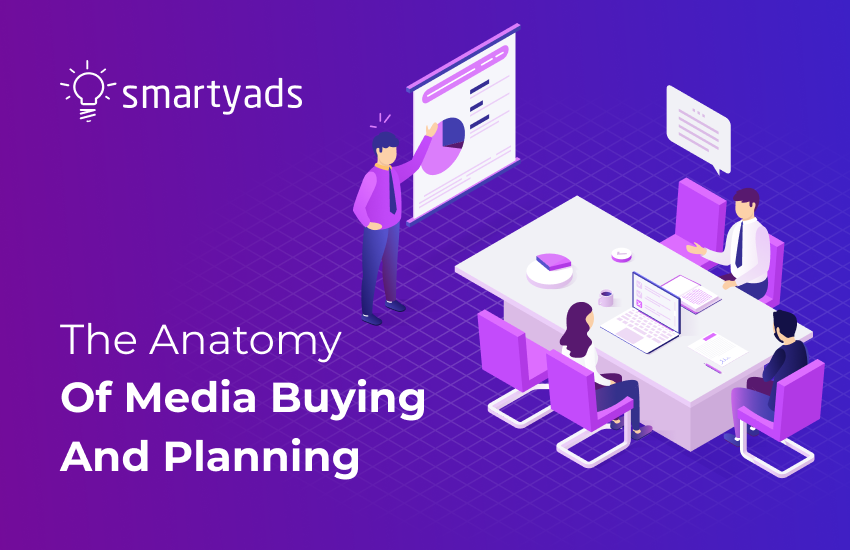
.webp)


